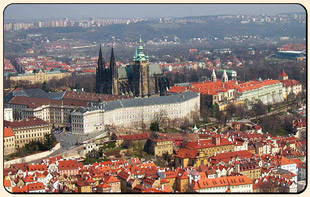 |
 |
 |
| |

Prague Castle
Prague Castle (Czech: Pražský hrad) is
where the Kings of Bohemia, Holy Roman Emperors
and presidents of Czechoslovakia and the Czech Republic have had
their offices. The Bohemian Crown Jewels are kept here. Prague Castle
is one of the biggest ancient castles in the world at nearly 570
meters
in length and averaging approximately 130 meters wide.
The history of the castle stretches back to the 9th
century (870). The first walled building was the church of Our Lady.
The Basilica of Saint George and the Rotunda of St. Vitus were founded
in the first half of the 10th century and the first convent in Bohemia
was founded in the castle, next to the church of St. George. A Romanesque
palace was erected here during the 12th century. In the 14th century,
under the reign of Charles IV, the royal palace was rebuilt in Gothic
style and the castle fortifications were strengthened.

The First Castle Courtyard We enter the castle through the First Castle Courtyard, enclosed
by a massive grille, whose pillars bear sculptural groups depicting
battling giants. The castle area itself is accessible through
the Matthias gateway which was the first secular Baroque project
in Prague. The Second Castle Courtyard
Passing through the gateway we enter the Second Castle Courtyard.
On the northern side we find the Gallery of Prague Castle,
containing remnants of the former Emperor collections. The
northern wing of the Second Courtyard is formed by the Spanish
Hall and the Rudolph Gallery. The Chapel of the Holy Cross
runs along the central palace.
The Picture Gallery - The collection of paintings at Prague
Castle, contains some four hundred paintings and drawings.
There we see the works of painters such as Tizian, Rubens and
others. The Imperial Stable now serves as an exhibition hall.
The oldest part of Castle is the ruin of The Church of our
Lady, where we see the tomb of the first princes from the 12th
century Premysl dynasty. In the middle of the Courtyard II
we see the Renaissance fountain, which supplied the castle
with drinking water in the past. |
The Third Castle Courtyard
The coronation jewels – the crown, the sceptre and the
orb – are housed in St. Vitus Cathedral, connected with
the Old Royal Palace, the seat of the Czech medieval sovereigns,
by a passage so a king could go from his bedroom directly into
the church. St. Vitus Cathedral St. Vitus Cathedral is the largest and the most important
church in Prague. A Gothic cathedral was built in the middle
ages, in the 14th and 15th centuries. The rest of the cathedral
was built much later, in the beginning of 20th century in
Neo Gothic style. It is difficult to recognize the old part
from the new one.
The Neo-Gothic part of the cathedral consists of the main
nave and the side chapels. The chapels have stained-glass windows.
You can also see the beautiful window by Alphonse Mucha. In
the center, you can see the entrance to the underground portion
- the royal crypt. Visit the tombs of Charles IV and his four
wives, Rudolf II and many Czech kings and queens.
In the old Gothic part of the cathedral you will see the chancel,
the altar or the beautiful ceiling. The windows and some decoration
come from the Baroque or New Gothic period.
|


|
 St. George Basilica
Yet, the oldest church building in the Prague Castle area
is the Basilica of St. George, the best-preserved relic of
Romanesque architecture in Prague. It has two towers from the
12th century and a Baroque façade. |
 Golden Lane Golden Lane
One of the most popular sights at Prague Castle is Golden
Lane, two rows of tiny houses, once inhabited by castle marksmen,
who guarded Prague Castle’s fortifications. The famous
writer Franz Kafka once lived in house No. 22.
|
|
|
 |
 |
 |







 Golden Lane
Golden Lane
